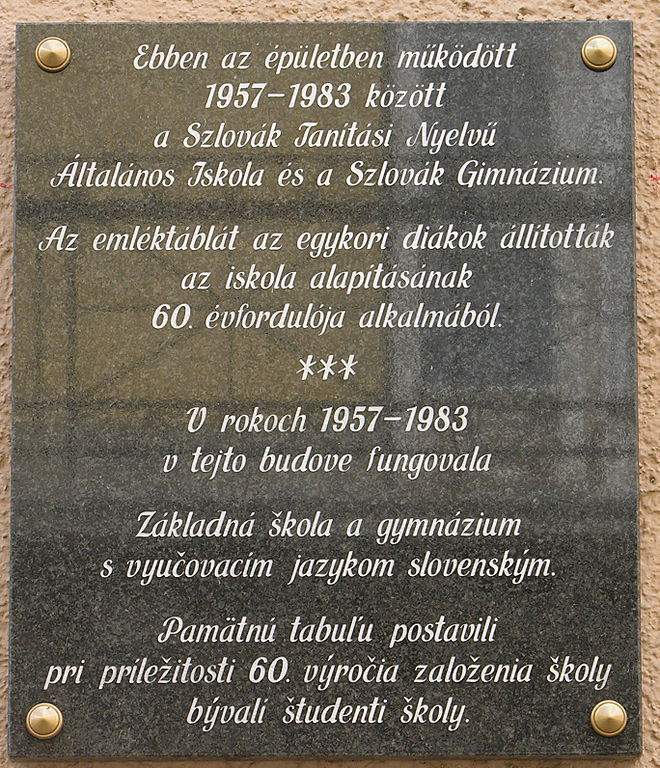Minorities in Hungary #7 – Slovaks
Slovaks arrived in Hungary relatively late in history, but it does not mean they did not affect Hungarian society greatly. Their first coming in large numbers dates back to the end of the 17th century with the mass migration towards the southwest. The Slovakian settlers moved to Hungary after the vanquishing of the Ottoman occupational forces, and they began to repopulate the abandoned South.
The dwellers of today’s Slovakia encountered Ottoman raids soon after the devastating defeat in Mohács, which caused great mass movements in the late 16th century. The threat from the South decreased the population of the territories close to the occupational zone’s borders. While the part of Hungary under Ottoman rule suffered losses in population due to the constant war, diseases, imprisonment and migration, the Slovakian area’s favourable circumstances resulted in overpopulation. When the southern territories were liberated, a vast number of Slovakian settlers arrived at the abandoned territories and repopulated them.
This process was enhanced by the greatest resettlement program of Hungary, which balanced the scales between the crowded North and the devastated South.
The descendants of these settlers live not only in today’s Hungary, but also in Romania and Serbia.
The other factor that brought many Slovaks to Hungary from the North was the promise of a better living, lower taxes and religious freedom. Most of them arrived as temporary workers, but they became settlers later. Their arrival proved to be useful in solving the critical labour shortage in the former Ottoman territories, which was urgent especially because these fertile lands needed people to cultivate it. Those Slovakian landlords who had properties in the North brought their servants to the South.
Most historians and sociologists differentiate three waves of Slovakian immigration. The first happened between 1690 and 1711 when the Northerner settlers moved to Komárom, Nyitra, Esztergom and Nógrád. The second wave came between 1711 and 1740 when they settled around Pest, Abaúj and Borsod County. Many of these immigrants were actually fugitive serfs.
Békéscsaba became a shelter for Evangelist Slovaks who were persecuted for their religion after 1717. The other great gathering point of Slovaks were the territories of Baron Harruckern, whose devastated properties in Szarvas were repopulated by the settlers. Many people were forced to move along later because of overpopulation, but Slovaks remained in the majority until 1731, when a mass of Hungarians arrived.
In the following decades, such events happened that lead to the fragmentation of Slovakian communities in Hungary.
The first was the peasant uprising in Békésszentandrás in 1735, which was caused by the heavy tax burdens and the frequent epidemics. In 1746, a conflict broke out between Evangelists and Catholics, so the former ones moved along. Nyíregyháza was also populated by Slovaks from Békéscsaba, Szarvas and Tótkomlós in 1754.
By the end of the 18th century, the Slovakian population in Hungary was separated into multiple “islands.” The three main groups were situated in Northeastern Hungary (Borsod-Abaúj-Zemplén, Nógrád and Pest), in Transdanubia (Komárom, Esztergom, Fejér and Veszprém) and the southeastern parts of the Great Plains (Békés and Csongrád).
After the end of World War II, Czechoslovakia was urging the Soviet Union to carry out the population exchange between Hungary and the Slovakian territories. The pact that allowed the exchange was signed by governor Beneš in Potsdam in 1946. The original idea was to deport the entire Hungarian population of Felvidék (“Upper Hungary”, which then belonged to Czechoslovakia) to Hungary and force the whole Slovakian community in Hungary back to Czechoslovakia.
This proved to be an uneven theory as one million Hungarians were meant to be deported in Czechoslovakia, while there was a quite low number of Slovaks living in Hungary.
In practice, hundreds of thousands of Hungarians were forced to move from the Slovakian territories to Hungary, while thousands of Slovaks voluntarily moved to Czechoslovakia — though it is still questionable today how “voluntarily” they did this actually. Despite the pressure of propaganda, many Slovaks stayed in Hungary. Many of those who moved to Czechoslovakia in the late 1940s returned later, mostly due to the cultural differences between Slovaks from Hungary and Czechoslovakia.

The bilingual sign of a Slovakian school in Békéscsaba. Photo: Wikimedia Commons
The Slovakian Municipal in Hungary was established in the early 1950s, and it has been regularly hosting theatre performances and festivals and supporting schools. It has been publishing the Slovakian journal L’udové noviny since 1957. Both the Hungarian National Television and the Hungarian National Radio broadcasts programs in Slovakian. A research group of Slovakian scholars was also founded in Hungary in order to research and preserve Slovakian language and culture. The National Day of Slovaks in Hungary is hosted every year in different locations.
The number of Slovaks in Hungary is constantly decreasing: there were more than 30,000 of them in 1960, but this number has halved by now.
The population census of 2001 reported 17,693 people admitting being Slovaks, being the third greatest minority in Hungary after the Roma people and the Germans. Also in this year, 11,816 people labelled Slovakian as their mother tongue and 26,631 admitted relating to the Slovakian traditions and culture.
Though they have been spread throughout Hungary in different diaspora communities for many years, most of the Slovakian population is concentrated now in Pilis and Békés, Békéscsaba being their cultural centre. However, a number Slovaks began to move to Hungary in the recent years, so they are expected to remain a significant minority in Hungary.
Source: Ujkor.hu, Korkep.sk, Sulinet.hu, Daily News Hungary
please make a donation here
Hot news
What happened today in Hungary? — 1 May, 2024
Budapest mayoral candidate of Fidesz promises clean, organised Budapest
New night service from this Hungarian city to Warsaw!
Von der Leyen: Hungarians made Europe stronger, Hungarian commissioner: This is not the EU we dreamt of
Trains and buses in Hungary now easier to track real-time!
Hungary celebrates its 20th anniversary of European Union membership




